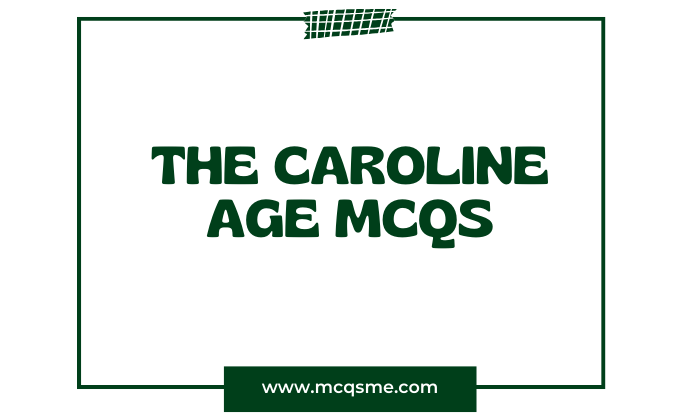
The Caroline Age is named after which English monarch?
A. Queen Elizabeth I
B. King Charles I
C. King James I
D. King Henry VIII
Which of the following genres was particularly popular during the Caroline Age?
A. Epic poetry
B. Metaphysical poetry
C. Pastoral poetry
D. Tragedy
What was a notable feature of Caroline literature in terms of style?
A. Plain and direct language
B. Complex and ornate imagery
C. Emphasis on emotional expression
D. Focus on moral and ethical issues
The Caroline Age is part of which larger literary period?
A. The Renaissance
B. The Enlightenment
C. The Romantic Era
D. The Victorian Era
Which of these poets is most associated with the Caroline Age?
A. John Donne
B. John Milton
C. Robert Herrick
D. Geoffrey Chaucer
The Caroline Age saw a decline in which type of literature that had been popular in the Elizabethan Age?
A. Sonnets
B. Pastoral poetry
C. Metaphysical poetry
D. Drama
The Caroline Age literature often reflected the tensions of which major English conflict?
A. The Hundred Years’ War
B. The War of the Roses
C. The English Civil War
D. The Spanish Armada
Which of the following themes was common in the Caroline Age poetry?
A. Exploration and adventure
B. Love and nature
C. Religious devotion
D. Political satire
The Masque was a popular form of entertainment during the Caroline Age. What is a Masque?
A. A dramatic poem
B. A type of dance
C. A courtly performance combining music, dance, and drama
D. A satirical play
Who was a leading figure in the development of the masque during the Caroline Age?
A. William Shakespeare
B. Ben Jonson
C. John Milton
D. Thomas Middleton
How did the Caroline Age literature differ from Elizabethan literature in its portrayal of human nature?
A. It presented a more idealized view
B. It focused on darker, more realistic aspects
C. It was heavily focused on the supernatural
D. It ignored human nature altogether
Which of the following is a characteristic feature of Caroline drama?
A. Religious themes
B. Political allegory
C. Psychological realism
D. Mythological references
What role did the Caroline Age play in the development of English prose?
A. It marked the beginning of modern English prose
B. Prose declined in popularity during this period
C. It focused exclusively on religious prose
D. It introduced the use of vernacular English in prose
Who among the following was a prominent Caroline prose writer known for his essays?
A. Francis Bacon
B. Thomas Browne
C. John Milton
D. Izaak Walton
The Caroline Ag literature often reflected the societal shift towards which of the following?
A. Greater religious tolerance
B. The glorification of war
C. The importance of the individual
D. A return to classical ideals
The Caroline Age was particularly known for which of the following in poetry?
A. The use of blank verse
B. Complex allegories
C. The sonnet form
D. The development of free verse
How did the English Civil War impact The Caroline Age literature?
A. It led to a decline in literary production
B. It inspired a new genre of war poetry
C. It caused a shift towards more patriotic themes
D. It influenced the rise of satirical literature
Which of these is a notable work of the Caroline age literature?
A. “Paradise Lost” by John Milton
B. “The Faerie Queene” by Edmund Spenser
C. “Astrophil and Stella” by Sir Philip Sidney
D. “To the Virgins, to Make Much of Time” by Robert Herrick
Which theme became less prominent in the Caroline age poetry compared to earlier periods?
A. Love and romance
B. Religious devotion
C. Nature and the pastoral life
D. Political and social satire
The Caroline Age is often seen as a bridge between which two literary periods?
A. Elizabethan and Jacobean
B. Jacobean and Restoration
C. Medieval and Renaissance
D. Renaissance and Enlightenment
Which artistic movement during the Caroline Age focused on intricate language and complex imagery?
A. The Metaphysical Movement
B. The Neoclassical Movement
C. The Romantic Movement
D. The Realist Movement
Caroline Age literature often reflected the political and social tensions of the time. Which group’s influence is notably seen in this literature?
A. The Puritans
B. The Cavaliers
C. The Roundheads
D. The Jacobites
Which Caroline poet was known for blending the metaphysical and pastoral styles in his works?
A. Andrew Marvell
B. Richard Lovelace
C. George Herbert
D. Thomas Carew
During the Caroline Age, which form of poetry saw a significant decline?
A. Epic poetry
B. Sonnet sequences
C. Lyrical ballads
D. Narrative poetry
The influence of which European culture was notably strong in the Caroline age literature and arts?
A. French
B. Italian
C. Spanish
D. German
What was a characteristic feature of the Caroline age drama in terms of its subject matter?
A. Historical events
B. Everyday life and domestic scenarios
C. Mythological stories
D. Courtly love and chivalry
Which Caroline poet is known for his elegies and religious poems?
A. John Donne
B. George Herbert
C. Richard Crashaw
D. Henry Vaughan
How did the economic conditions of the Caroline Age influence its literature?
A. It led to a focus on wealth and materialism
B. It caused a decline in the patronage of the arts
C. It inspired literature that critiqued social inequality
D. It had little to no impact on literature
What was the status of women writers during the Caroline Age?
A. They were highly celebrated
B. They were largely absent from the literary scene
C. They often published anonymously or under pseudonyms
D. They focused mainly on writing religious texts
Which aspect of the Caroline age theatre was significantly different from the Elizabethan era?
A. The use of elaborate stage sets
B. The inclusion of female actors
C. The length of the plays
D. The focus on comedic elements

